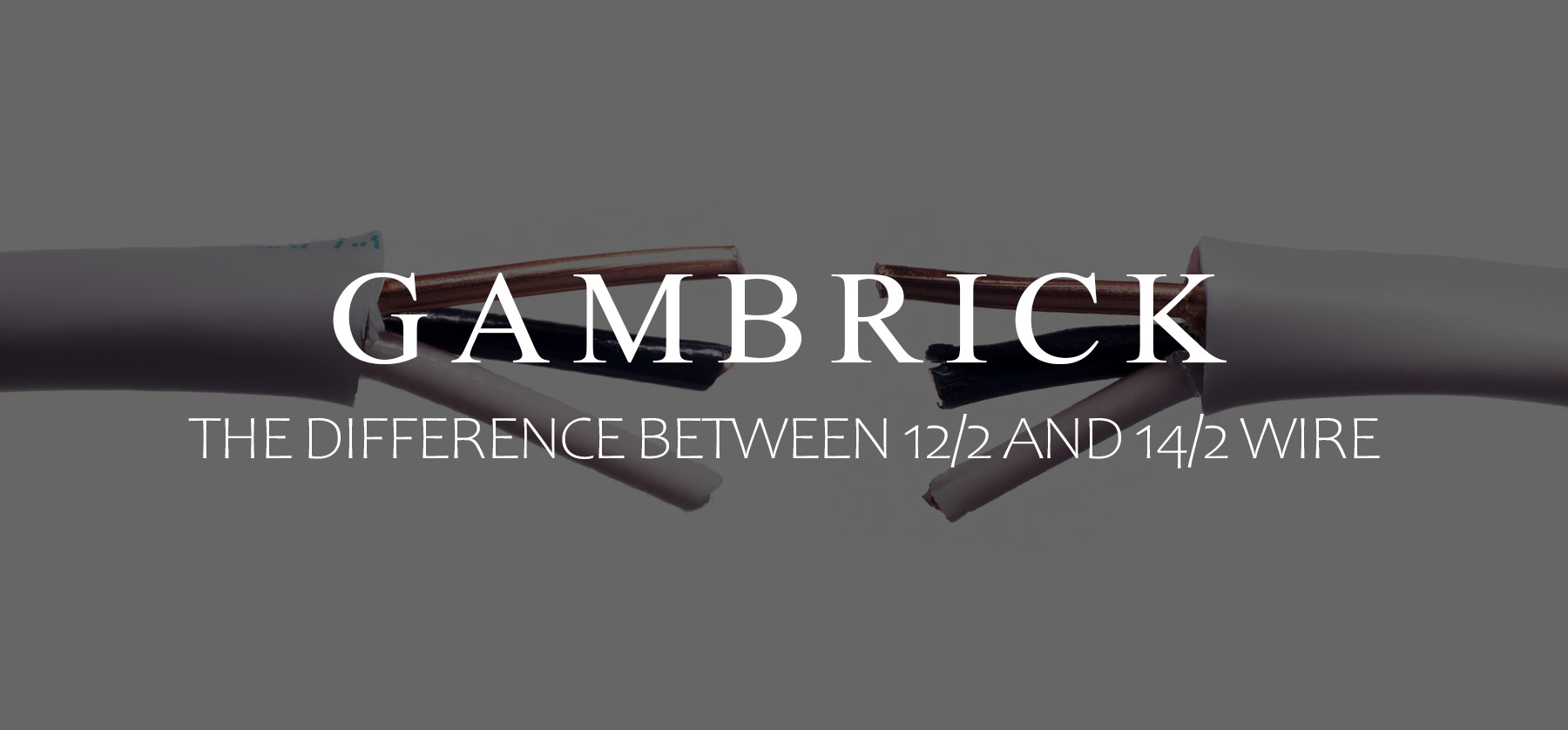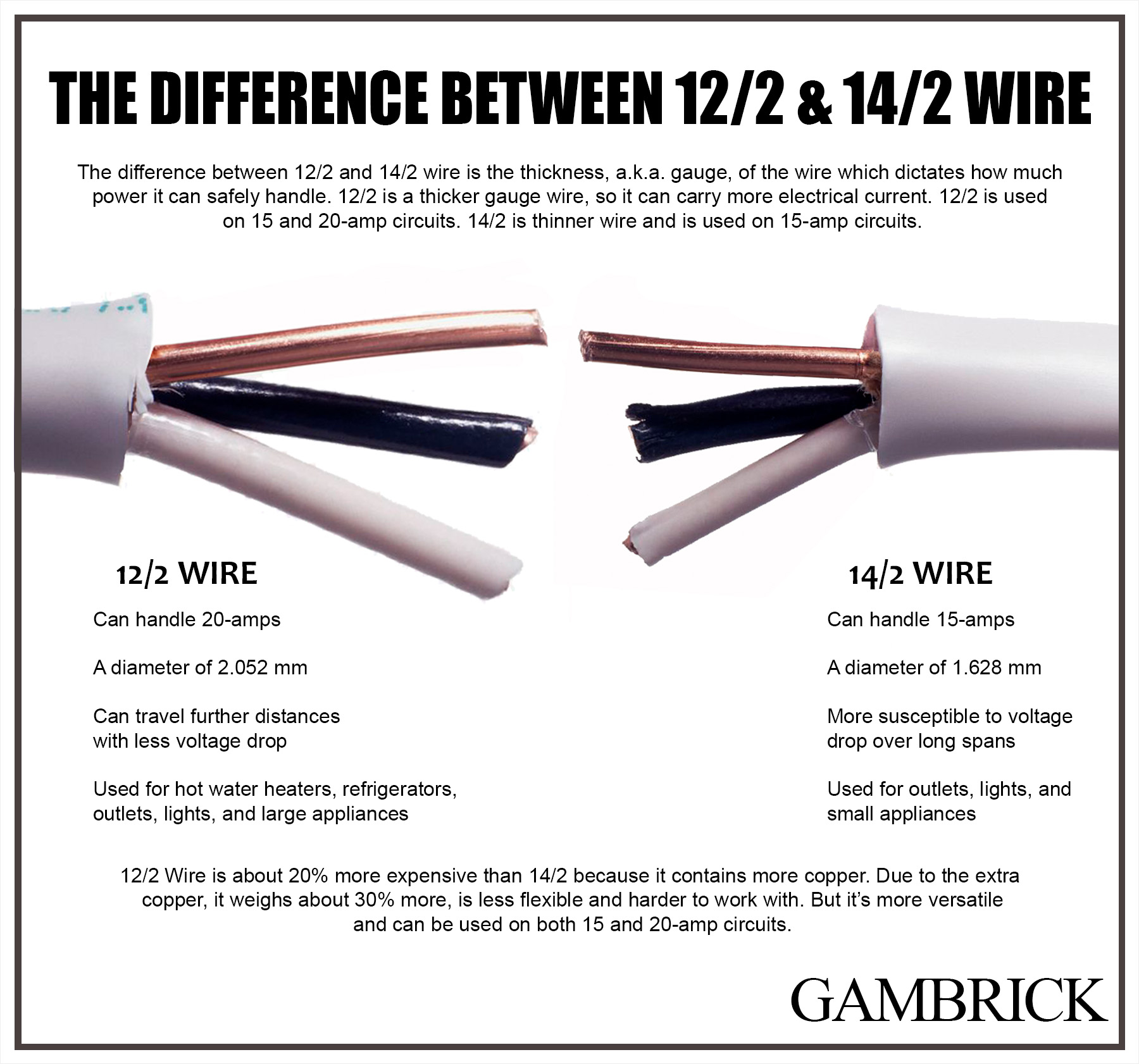The Difference Between 12/2 And 14/2 Wire
The difference between 12/2 and 14/2 wire is the thickness, a.k.a. gauge, of the wire and how much power it can safely handle. 12/2 is a thicker gauge wire, so it can carry more electrical current. According to the National Electric Code (NEC), it should be used on a 20-amp circuit with a 20A circuit breaker. 14/2 is a thinner gauge wire so it can’t carry as much electrical current. It’s rated for a 15-amp circuit with a 15A breaker. You can also use 12/2 wire on a 15-amp circuit because it’s a thicker wire that candle 15-amps. But you can’t use a 14/2 wire on a 20-amp circuit because it’s too thin to handle 20-amp of power.
The numbers 12/2 and 14/2 refer to the gauge of the wire and how many live wires are in the sheath. When buying wire, remember the first number is the wire’s gauge and the second is the wire count.
Because 12/2 wire is thicker and can be used on both 15 and 20-amp circuits, it’s more versatile, but it’s also more expensive, harder to work with and more expensive.
Many large appliances and power tools require 20-amps to work properly. For this reason, most builders use 12/2 wires throughout the home so their wiring will work with either a 15-amp or 20-amp circuit. This makes upgrading 15-amp circuits to 20-amps very easy because the existing wiring can handle the extra power.
To recap, the difference between 12/2 and 14/2 wire is the thickness of the wire and how much power it can safely handle without risking an overload. This then changes where and when you can use the wire.
The Difference Between 12/2 And 14/2 Wire
The difference between 12/2 and 14/2 wire is its thickness and the amount of amperage it can safely handle. A wire’s gauge refers to its thickness. The lower the number, the thicker the wire. 12-gauge wire is thicker than 14-gauge wire, so it can carry more power.
The thicker the wire (lower gauge), the more amperage it can handle without overheating or risking a fire. Thicker wire is also able to carry electricity for longer distances without voltage drop.
12/2 gauge wire is typically used on 20-amp circuits, while 14/2 gauge wire is used for 15-amps. Both wire gauges are commonly used in residential homes for different purposes.
| 12/2 wire | 14/2 wire |
| Can carry 20 amps | Can carry 15 amps |
| 12 gauge wire has a diameter of 2.052 mm | 14 gauge wire has a diameter of 1.628 mm |
| Thicker and can carry more amperage | Thinner so it can’t carry as much amperage |
| Can travel further distances without voltage drop | More susceptible to voltage drop over long spans |
| Used for hot water heaters, refrigerators, outlets, lights, and large appliances | Mostly used for outlets and lights |
Both 12/2 and 14/2 residential wires contain 2 live wires and a ground: black, white and a copper or green ground.
The black and white wires are “hot, ” meaning they conduct electricity. The ground wire doesn’t conduct electricity but is very important because it grounds the circuit. The ground wire is either green or bare copper.
Both 12/2 and 14/2 wiring comes wrapped in an outer sheathing. The color of the sheath dictates where the wire should be used. For example, white and yellow wire are generally used indoors, while grey sheathing means it’s an outdoor wire.
How Thick Is 12/2 Gauge vs. 14/2 Gauge Wire?
12/2 gauge wire can handle more amperage than 14/2 gauge wire because it’s thicker. Wire is made from copper, which is an excellent conductor of electricity. As electricity runs through the wire, it produces heat. Wires need to be thick enough to safely handle the power running through them without overheating. 12/2 wire is 2.052mm while 14/2 wire is just 1.628mm. This may not sound like much, but in terms of wiring, it is.
The difference in thickness between 12/2 and 14/2 wire is why 14-gauge wire is used for 15-amp circuits and 12-gauge wire is used for both 15 and 20-amp circuits.
Here’s a chart showing the thickness of both 12 and 14-gauge wires:
| Wire Gauge | Thickness In Inches | Thickness In MM |
|---|---|---|
| 12 | 0.0808″ | 2.052mm |
| 14 | 0.0641″ | 1.628mm |
Keep in mind this thickness is for each individual wire in a 12/2 or 14/2 wire.
When you buy wire it will have two numbers, for example 12/2 or 14/2. The first number is the gauge of each wire, the second number is how many hot wires are in the sheathing.
- 12/2 wire has two 12-gauge hot wires and a ground.
- 14/2 wire has two 14-gauge hot wires and a ground.
The thickness of a wire is measured at the copper, not it’s sheathing.
When Should I Use 12/2 Wire?
A 12/2 wire can carry 20 amps of power and can be used on either a 15-amp or 20-amp circuit. It can be used for lighting and outlets or appliances.
Because 12/2 wire is thicker than 14/2, it’s also more expensive. This is due to using more copper per wire. But it’s a better conductor of electricity, can handle more power, and suffers less voltage drop over long spans.
Many builders like myself use 12/2 wire on 20 and 15-amp circuits instead of 14/2 because it’s more versatile. A 15-amp circuit using 12/2 can be upgraded to a 20-amp circuit by simply changing the breaker. But a 15-amp circuit using 14/2 wire can’t be upgraded to 20-amp because 14/2 can’t handle 20-amps of power.
Most household appliances run on 12/2 wire with a few exceptions, such as certain electric dryers, duel fuel ranges, and air conditioning units. These large appliances usually use a 10/2 wire instead.
Below is a list of common household applications that use 12/ wire:
- Electrical Outlets
- Kitchen or Bathroom Exhaust Fans
- Dishwasher
- Dryers
- Lighting Fixtures
- Ceiling Fans
12/2 wire is thicker and can handle more power than 14/2 wire, so it’s generally safer to use because there’s less risk of an overload. When in doubt, I almost always use 12/2 because it works on both a 15 and 20-amp circuit. However, wire is very expensive right now, and 12/2 costs about 20% more than 14/2, which is about 14 cents extra per foot.
When Should I Use 14/2 Wire?
A 14/2 wire can carry 15 amps of power and is used on a 15-amp circuit. It’s usually used to wire household outlets, switches, lighting, and appliances that require no more than 15-amps.
Here are some examples of things commonly powered by 14/2 wire:
- Interior Light Fixtures
- Outlets
- Switches
- Smoke Detectors
- Small appliances
- Ceiling Fans
You should never use 14 AWG on a 20-amp circuit. 20-amps is too much power for a 14 gauge wire and can cause overheating and possible fire.
The maximum amount of receptacles you can power with 14/2 wire is 8. Since most outlets have 2 receptacles, you can typically wire 4 outlets to a single 15-amp circuit using 14/2 wire. If you want to put additional outlets on the circuit, use a 20-amp breaker with 12/2 wire instead.
Be aware that 14/2 wire is more susceptible to voltage drop over long distances than 12-gauge wire. If you need to wire extra long spans, it may be a good idea to upgrade to a 12/2 wire.
I use 14/2 a lot less than 12/2 wire. It’s great for small rooms that don’t have many receptacles or lights. A small office, exercise room, closet, sunroom, or den are examples where I may use 14/2 instead of 12/2.
Can I Use 14/2 Wire For An Outlet?
14/2 wire can be used to wire an outlet on a 15-amp circuit. A 14-gauge wire on a 15-amp circuit can power a total of 8 receptacles, which is 4 outlets. If you want to put more outlets on the circuit, upgrade to a 20-amp circuit with a 12/2 wire.
Never use 14-gauge wire for an outlet on a 20-amp circuit because the amperage is too high. You’ll risk overheating the wire, failure and a possible fire.
- 14-gauge wire is safe to use when wiring an outlet on a 15-amp or lower circuit.
- Never use 14-gauge wire for an outlet on a circuit over 15-amps.
- Check your breaker box to find out the amperage of the circuit your outlet is on.
To find the amperage of the circuit your outlet is on, check the breaker box. Locate the circuit breaker that controls power to the outlet. The amperage should be printed on the breaker handle. A “15” indicates a 15 amp circuit while a “20” indicates a 20 amp circuit.
If the circuit is 15-amp, it’s safe to use 14/2 wire for the outlet. However a 12-gauge wire loses less voltage on long distance runs, which is called voltage drop. In some cases it may be better to use a 12/2 wire even though a 14/2 will work.
Can I Use 12/2 Wire For An Outlet?
12-gauge wire can be used to wire an outlet on a 20-amp circuit. However it’s also safe to use 12-gauge wire on less powerful circuits like 15-amp. Many builders use 12 gauge wiring on 15-amp circuits just in case they want to upgrade to a 20-amp circuit later on.
12-gauge wiring works equally well for both 15 and 20-amp circuits.
Because 12-gauge wires are thicker than 14-gauge, there’s less voltage drop with long-distance runs. If a run is long, you may have to upgrade to a 12-gauge wire on a 15-amp circuit, even though a 14-gauge is technically thick enough. Using a thicker wire can help avoid excess voltage drop.
- 12-gauge wire can be used to wire outlets on both 15 and 20-amp circuits.
- Do not use 12-gauge wire for an outlet on a circuit with over 20 amps.
- 12-gauge wire is more expensive than 14-gauge wire.
If you’re wiring a circuit that’s over 20 amps, you’ll need a thicker wire. For example, a 30-amp circuit requires a 10-gauge wire.
As a general rule, 12-gauge wiring is used to wire outlets on either a 15 or 20-amp circuit.
How Many Outlets Can You Put On 14/2 Wire?
14/2 wire is used for a 15-amp circuit with 8 receptacles, which is 4 standard outlets with 2 receptacles per outlet. As a general rule of thumb, each outlet should draw about 1.5-amps, and you should only use about 80% of a circuit’s max amperage. This means a 15-amp circuit using 14/2 wire can power 8 receptacles.
Can I Use 12/2 Wire For An Outlet?
12/2 wire can be used to wire an outlet on a 20-amp circuit. However, you can also use 12/2 on a less powerful 15-amp circuit. Many builders use 12/2 wiring on 15-amp circuits because it’s easier to upgrade the circuit to 20-amp later if they choose to. Another benefit is that there’s less voltage drop on long runs with 12/2 vs. 14/2 because the wire is thicker.
12/2 wiring works equally well for both 15 and 20-amp circuits. However, 14/2 can only be used for 15-amp circuits. This makes 12/2 a more versatile wire size.
- 12/2 wire can wire outlets on 15- and 20-amp circuits.
- Don’t use 12/2 wire for an outlet on a circuit with over 20 amps.
If you’re wiring a circuit that’s over 20 amps, you’ll need a thicker wire than 12/2. For example, a 30-amp circuit requires a 10-gauge wire.
How Many Outlets Can You Put On 12/2Wire?
12/2 wire is used for both 15 and 20-amp circuits. I recommend figuring 1.5 amps per outlet. If your 12/2 wire is on a 15-amp circuit, the maximum number of outlets would be 10. If you’re on a 20-amp circuit, you can go up to 10 outlets. Most electricians recommend maintaining an 80% threshold, which means eight outlets at 15-amps or ten at 20-amps.
What’s Bigger 12/2 Or 14/2 Wire?
12/2 is a bigger wire than 14/2 wire, which means it’s thicker with a lower gauge. 12-gauge wire has a diameter of 2.052 mm, while 14-gauge has a diameter of 1.628 mm. This makes 12-gauge wire about 30% thicker than 14-gauge. It may not seem like much difference, but in terms of the wire’s ability to safely carry electrical current, it’s a lot.
- Because 12-gauge wire is about 30% thicker than 14-gauge wire, it can safely carry more electrical currents and suffers less voltage drop. 12/2 wire can handle 20-amps vs the 15-amps of 14/2 wire.
- This is a major difference when it comes to wire a household’s electrical system. 14/2 is used primarily for outlets, switches, and lighting. But 12/2 can handle outlets, switches, lighting, ceiling fans, appliances, and more.
When in doubt, I almost always use 12/2 instead of 14/2 wire in a home. It can carry more power, suffers less voltage drop and can be used on either a 15 or 20-amp circuit which makes it more versatile. The only downside is that it’s about 20% more expensive and about 30% heavier, making it harder to handle large spools.
How Many Lights Can You Put On A 12/2 Wire?
How many lights you can put on a 12/2 wire depends on the wattage of the lights. To determine how many lights you can put on your 12/2 gauge wire, you can use the formula Watts = Volts x Amps. For a 12/2 gauge wire, the number of lights is 30×15=450 Watts. You can safely load 450 Watts on 12/2 gauge wires.
- Once you know the wattage of your lights, divide them by 450 to figure out exactly how many lights you can put an a 12/2 wire.
- For example, let’s say you’re wiring 100-watt lights with 12/2 wire. 100/450 = 4. So you can wire 4 100 watt lights with 12/2 wire.
Another factor to remember is to put no more than 10 receptacles on a 20-amp circuit with #12 wire. If you’re wiring a light on the same circuit as a receptacle, remember to factor in the power usage of the receptacle as well as the light.
Can 14-2 Wire be Used For Lights?
14/2 wire can be used for standard-size lights like pendants, recessed lighting, small chandeliers, ceiling fans, track and rail lights, and flush lights. Keep in mind that 14/2 wire is typically used on 15-amp circuits, so divide the power requirements of your lights by the power supplied by the circuit.
When wiring lights with 14/2, always consider the total amount of power a 14-gauge wire can handle as well as the power requirements for each light. In many cases, it’s better to use thicker 12/2 wire instead because it can handle more power.
The Pros & Cons Of 12/2 vs. 14/2 Wire
As a general rule of thumb, 12/2 wire is for outlets on a 15 or 20-amp circuit while 14/2 wire is for outlets on a 15-amp circuit. They’re both very common wire gauges used in residential construction. And like all things, each wire size has some pros and cons you should know about.
In this next section we’ll discuss the pros & cons of 12/2 and 14/2 wiring.
12/2 Wire Pros
12/2 wire is thicker than 14/2 wire which means it can handle more amperage. This makes it more versatile because you can use it on both 15 and 20-amp circuits.
Because 12-gauge wire is thicker copper, there’s less voltage drop on ling runs.
Using 12/2 wire on 20-amp circuit allows you to wire up to 10 receptacles. Whereas a 15-amp circuit can only power 8. A standard outlet counts as two receptacles, a top and a bottom. So a 20-amp circuit using 12/2 wire can generally power 10 outlets. This provides a lot of flexibility when wiring a home because a single circuit can usually power all the outlets in a room.
- 12/2 wire can be used for both 15 and 20-amp circuits.
- A 20-amp circuit wired with 12-gauge wire can power up to 10 outlets.
- Outlets wired with 12/2 wire on a 20-amp circuit can power most large appliances and power tools.
- 15-amp circuits can’t power most large appliances.
One of the biggest benefits to using 12/2 wire is its versatility. Running all your outlets on 20-amp circuits with 12-gauge wire can power larger appliances and power tools. This includes most window A.C. units, heaters, refrigerators and more.
Using a 12/2 wire for a 15-amp circuit is a good idea if there’s a chance you could upgrade to a 20-amp circuit later on. Since a 12/2 wire can handle 20-amps, you don’t have to change the wiring when bumping-up the circuit’s amperage.
A pro of using 12/2 wire is that you can use it for both 15 and 20-amp circuits which covers the majority of a home’s electrical requirements.
12/2 Wire Cons
12/2 wire is about 20% more expensive than 14/2 because it’s thicker copper. If you’re looking to save money, run 14/2 wire to your 15-amp outlets and recessed lights. 12/2 is also about 30% heavier than 14/2, which makes is harder to use on large spans.
- 12/2 wire is about 20% more expensive than 14/2.
- 12-gauge wire is thicker which makes it harder to bend and snake through openings.
- I use larger wire nuts with 12/2 wire vs 14/2.
- 12/2 is about 30% heavier than 14/2.
Because 12/2 wire is thicker copper, it’s a little harder to work with. Bending the wire and snaking it through small openings is harder to do compared to 14/2 wiring.
12-gauge wire is thicker so I use larger wire nuts when joining two or more wires together. It’s not harder to do but costs a little more money.
14/2 Wire Pros
14/2 wire is thinner copper with makes it about 20% less expensive than 12/2 wire. It’s also more flexible and easier to work with because it’s about 30% lighter. 14/2 is easy to snake around corners and through small openings because it’s easier to bend.
- 14/2 wire is about 20% cheaper than 12/2 wire.
- It’s very flexible and easy to snake which makes it easier to work with than 12-gauge wire.
- A good choice for residential outlets on a 15-amp circuit.
14/2 wire is very common in residential construction and is the standard gauge used for 15-amp circuits. Most rooms other than kitchens, bathrooms and garages use 15-amp circuits with a 14/2 wire.
14/2 Wire Cons
15-amp circuits with a 14/2 wire don’t have enough power for most large kitchen appliances, power tools or window AC units to operate properly. They also can’t run as many receptacles or lights on a single line. In most cases all you can have is 4 outlets per circuit vs 8 to 10 with a 20-amp circuit and 12/2 wire.
- 14/2 wire with a 15-amp circuit won’t provide enough power for AC units, power tools, and other large appliances.
- If you use 14/2 wire on a 15-amp circuit and want to upgrade to 20-amps, you’ll have to replace all the wiring with 12/2.
- If you run 12/2 wire on a 15-amp circuit, you can upgrade the circuit by simply changing the breaker. This is much easier and cheaper to do because the wiring can handle 20-amps.
- You can’t use 14/2 wire and 15-amps for every outlet. Most kitchen and bathroom outlets must have a 20-amp circuit with 12/2 wire.
If you use 12/2 wire on a 15-amp circuit, you can easily upgrade the circuit to 20-amps by simply replacing the breaker. The existing 12-/2 wiring can handle 20-amps of power, which is an advantage over using 14/2 wire.
If you use a 14/2 wire for a 15-amp circuit, the only way to upgrade to 20-amp is by rewiring the entire circuit with 12/2 wire. This is very difficult and expensive to do if the home is finished.
Most kitchen and bathroom outlets must have a 20-amp circuit with at least 12/2 wire. I also use 12/2 and 20-amps for outdoor and garage outlets because of my power tools and lawn equipment.
A con of 14/2 wire is that it’s too thin for 20-amp outlets which are often required in a home.
Is It OK To Mix 12/2 And 14/2 Wire?
It’s OK to mix 12/2 and 14/2 wire on the same circuit as long as the wire size is rated for the amperage of the circuit. For example, if you have a 15-amp circuit, it’s OK to use both 12/2 and 14/2 wire because both gauges are rated for 15-amps. However, you can’t use both 12/2 and 14/2 wire on a 20-amp circuit because 14/2 wire is too thin for 20-amps.
Some electricians run 12/2 wire to outlets on a 15-amp circuit but use 14/2 from a switch to a fan. This is OK as long as the circuit is 15-amp. But if you upgrade the circuit to 20-amp, the 14/2 should be switched to 12/2.
- Don’t connect 12/2 and 14/2 wire to one another.
- Its OK to use 12/2 and 14/2 wire on the same circuit as long as they’re not undersized for the amperage.
- I use the same gauge wire for all my outlets in a circuit.
- Its OK to use different wire gauges for different circuits in the home as long as the wire is rated to handle the amperage of the circuit.
Using 12/2 and 14/2 wires in the same home is OK. For example, the kitchen and bathroom circuits are usually a 20-amp circuit with a 12/2 wire. But the living room, bedrooms, hallways, closets, dining room, office, etc., are usually a 15-amp circuit with a 14/2 wire.
Should I Use 12/2 or 14/2 Wire For Outlets?
Both 12/2 and 14/2 wires are used for outlets. Which you should use depends on the amperage of the circuit. 14/2 wire can be used to wire 15-amp outlets, but 14/2 wire can be used for both 15-amp and 20-amp circuits.
Here’s a chart showing the wire gauge most commonly used for home outlets.
| Wire Use | Circuit Amperage | Wire Gauge |
|---|---|---|
| Light fixtures, lamps, lighting circuits, indoor receptacles (outlets), small appliances | 15-amps | 14/2 or 12/2 |
| Kitchen, bathroom, and outdoor receptacles (outlets), 120-volt air conditioners, large appliances | 20-amps | 12/2 |
Remember the following:
- Use a 14/2 wire on 15-amp circuits.
- Use a 12/2 wire on either 15 or 20-amp circuits.
- The amperage of the circuit should be listed on the circuit breaker’s handle.
Never use a wire gauge that’s too small for the amperage of the circuit. If the power is too much for the wire, it could get hot, melt the sheathing and ignite flammable materials, which could cause a fire.
Here are a few things to consider when comparing 12/2 vs. 14/2 wiring:
- 12/2 wire can be used for 15 and 20-amp circuits.
- 14/2 wire can only be used on a 15-amp circuit or less.
- Using 12/2 wire for all your outlets allows you to upgrade a 15-amp circuit to 20-amps without changing the wiring.
- It’s very hard and expensive to upgrade a 15-amp circuit to 20-amps if it’s wired with 14/2 wiring.
- 12/2 is about 20% more expensive than 14/2 wire.
- 14/2 wire is easier to work with because it’s more flexible and about 30% lighter.
Most homes use both 12/2 and 14/2 wires in the same house because they have 15 and 20-amp circuits.
What Can I Use 14/2Wire For?
14/2 wire is used for 15-amp circuits used for light fixtures, lamps, lighting circuits, and receptacles (outlets). You can tell if a circuit is 15-amps by checking the circuit breaker. The amperage is generally written on the breaker’s handle.
12/2 wire is used in kitchens and bathrooms, for outdoor receptacles, 120-volt air conditioners, and receptacles (outlets) with either 15 or 20-amp circuits.
Can I Use 14/2 Wire On A 20-Amp Circuit?
No. You should never use 14/2 wire on a 20-amp circuit. The wire isn’t thick enough to handle that much amperage, which means it could overload and potentially cause a fire.
The minimum wire size you need for 20-amps is 12-gauge, a.k.a. #12 wire. If you use an undersized wire, a few things can happen.
- The wire can get red hot from all the power, just like the filament in a toaster. This can eventually melt the wire’s sheathing, which could start a fire if flammable materials are around the wire.
- Even if a fire doesn’t start from using an undersized wire, the resistance will likely cause a voltage drop to the appliances on the circuit. This can cause electric motors, pumps, or compressors to malfunction or stop working.
The heat generated in the wires is wasted energy that may increase your electric bill.
Can I Run 12/2 Wire To A 15-Amp Outlet?
Yes, it’s OK to run 12/2 wire to a 15-amp outlet. A 12/2 wire is rated for a 20-amp circuit so it’s thick enough to handle 15-amperage.
Many electricians will run 12-gauge wire on a 15-amp circuit throughout a home because it makes upgrading to 20-amps easier. All you have to do to upgrade a 15-amp circuit with 12/2 wire to 20-amps is change the breaker.
However if you have a 15-amp circuit with 14-gauge wire, you have to change the breaker and all the wiring. This is very hard and expensive to do once the house is finished.
Using a thicker wire than you need also helps reduce voltage drop on long runs. This is something worth considering if you live in a very long house.
There are two main downsides to running 12/2 wire to 15-amp outlets:
- Cost: 12/2 wire is about 20% more expensive than 14/2.
- Work: 12/2 wire is harder to work with than 14/2 because it’s thicker, less flexible and about 30% heavier.
It’s OK to run a 12/2 wire to a 15-amp outlet, however, it’s harder to work with and more expensive.
Conclusion
The difference between 12/2 and 14/2 wire is the thickness, or gauge, of the wire. 12/2 is thicker, so it can handle more total power. Use 12/2 on a 20-amp circuit to power lights, outlets, switches, appliances, ceiling fans, etc. 14/2 wire is thinner, so it only powers a 15-amp circuit. Use it to wire lights, outlets, switches, and smaller appliances.
Both a 14/2 and 12/2 wire have two live wires, a black and a white, and a ground that’s either bare copper or green. The wires are wrapped in an outer sheath that’s color-coded, telling you the wire’s intended purpose. For example, yellow or white is indoor wire, and grey is outdoor.
- 12/2 wire is used for both 15-amp and 20-amp circuits. It can be used for lighting, outlets, switches, and larger appliances. 12/2 wire is about 20% more expensive because it uses more copper. It’s also about 30% heavier, which makes it harder to work with over long spans.
- 14/2 wire is thinner, cheaper, lighter, and easier to work with. It’s used on a 15-amp circuit to power outlets, switches, small appliances, and lights.
When in doubt, I generally use 12/2 vs 14/2 wire. A 12/2 wire will work on both a 15 and a 20-amp circuit. But a 14/2 wire only works with a 15-amp circuit. If you use 12/2 to wire a 15-amp circuit, you can easily upgrade to 20-amp later by simply changing the breaker.
However, if you want to upgrade a 15-amp circuit with 14/2 wire to 20-amps, you must change all the wiring. This is very expensive and hard to do.
Summary: The Difference Between 12/2 And 14/2 Wire
The difference between 12/2 and 14/2 wire is the thickness, a.k.a. gauge, of the wire and how much power it can safely handle. 12/2 is a thicker gauge wire, so it can carry more electrical current. According to the National Electric Code (NEC), it should be used on a 20-amp circuit with a 20A circuit breaker. 14/2 is a thinner gauge wire so it can’t carry as much electrical current. It’s rated for a 15-amp circuit with a 15A breaker. You can also use 12/2 wire on a 15-amp circuit because it’s a thicker wire that candle 15-amps. But you can’t use a 14/2 wire on a 20-amp circuit because it’s too thin to handle 20-amp of power.
- The numbers 12/2 and 14/2 refer to the gauge of the wire and how many live wires are in the sheath. The first number is always the wire gauge, and the second is the wire count.
- Because 12/2 wires are thicker and can be used on both 15 and 20-amp circuits, it’s more versatile, but its also more expensive, harder to work with, and heavier.
To recap, the difference between 12/2 and 14/2 wire is the thickness of the wire and how much power it can safely handle without risking an overload. This then changes where and when you can use each wire.
If you have any questions or comments about the difference between 12/2 and 14/2 wire, email any time.
























